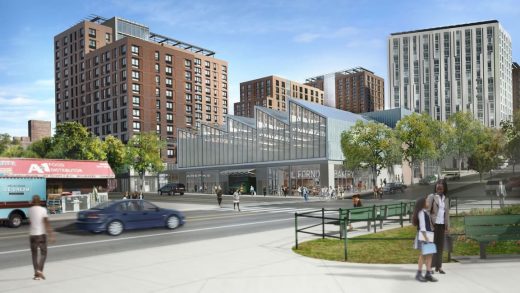Food waste makes up 30% of household garbage. These massive machines turn it into fertilizer
In residential buildings, people throw out a lot of garbage, and a huge portion of it is food. An estimated 30% of the garbage of a typical household is food scraps and food that’s gone to waste. When it comes to garbage day, all this food waste—which is mostly water and quite heavy—gets trucked away at great environmental expense.
A new building in the Bronx has found a way to keep this waste on site and turn it into something productive. Through the use of an on-site aerobic digester—a kind of biological machine in which microbes quickly devour and process food waste—the waste will be converted into organic fertilizer.
The digester is part of the Peninsula, a multiphase project from Gilbane Development Company and Hudson Companies that will eventually include 740 units of affordable housing and 15,000 square feet of commercial space. The first two buildings to be completed are a residential tower and a 50,000-square-foot industrial space that will house several food companies. The digester will live in the basement of this food-focused industrial building, and food scraps from the residential building (and others still to be developed), will be hauled over daily for processing. Special food waste bins will be given to every resident.

Built by Harp Renewables, the digester looks like a cross between a dumpster and a dishwasher and, in a single day, can turn 1,100 pounds of discarded food scraps into about 220 pounds of fertilizer.
It comes at a time when fertilizer is a surprisingly lucrative commodity. The prices of the raw materials in fertilizer, including mined potash and industrially manufactured ammonia, have hit record highs, due in part to the war in Ukraine, where many fertilizer ingredients are produced. The fossil fuels required to turn these ingredients into commercial fertilizers only makes the situation worse, boosting emissions and exacerbating climate change.
An in-building aerobic digester brings this fickle supply chain into the basement, virtually eliminating fossil fuels from the production process.
Clare Miflin, founder of the Center for Zero Waste Design, was brought in to advise on the project. She says this kind of technology can play a big role in reducing the amount of garbage commercial and residential buildings produce. “There’s a lot of solutions that have to fit together,” she says. “This is a great one because it allows a building manager to deal with food waste immediately, it reduces rats and odor because they can put waste in every day, and it reduces trucking.”
It also produces useful, and potentially valuable, fertilizer, says Christina Grace, founder of the zero-waste company Foodprint Group, which helped plan and design the implementation of the digester. The building’s management company, MHANY, will operate it. “Over time it will be a very cost-effective thing for MHANY to handle the organics in both of the buildings,” she says.

The digester cost about $50,000 to install, which was offset by a 40% grant from the State of New York. Grace estimates that it will take about three to five years for the digester to pay for itself through reduced waste-collection fees.
Grace says that, for now at least, the fertilizer will be donated. “The goal is for this material to work its way into the community garden network in the Bronx,” she says. “We see this as highly replicable in both commercial and residential venues. We know there’s a need for fertilizer.”
Though this is the first project in New York State to use an aerobic digester, the technology is slowly entering the residential building space as a waste-processing alternative. Grace says another digester is currently being added to a multifamily residential building in Brooklyn. Similar digesters have been installed in places like a hotel in Ireland and a zoo in Cincinnati. But there are still challenges in using this technology. Miflin notes that building codes aren’t set up to handle them and the ventilation they require. Miflin says ventilation could be added to the plumbing vents that buildings already have; but for now they’re being kept separate, which can add to their cost.
Another successful installation was completed by @Nuplanetss at Cashel Palace Hotel.
The Harp CX2 Biodigester can digest up to 2000L of waste per week. Our industry-leading technology reduces the waste volume and weight by up to 85% in less than 24h. pic.twitter.com/lZwSYB9h8i
— Harp Renewables (@Harp_Renewables) August 20, 2021
Miflin and Grace say this kind of device can eventually provide an economic return, making it easier to justify their cost and potentially easing the construction process.
One other major benefit of this approach to waste management: fewer pests. In New York City, where most garbage is still bagged and left on sidewalks for pickup, food waste is a magnet for the city’s famous rats and cockroaches. Eliminating food waste from the garbage stream could also eliminate the scavengers this rotting food attracts. “I think it can help you get to a pest-free building, and definitely a pest-free sidewalk,” says Miflin.
Fast Company , Read Full Story
(20)



